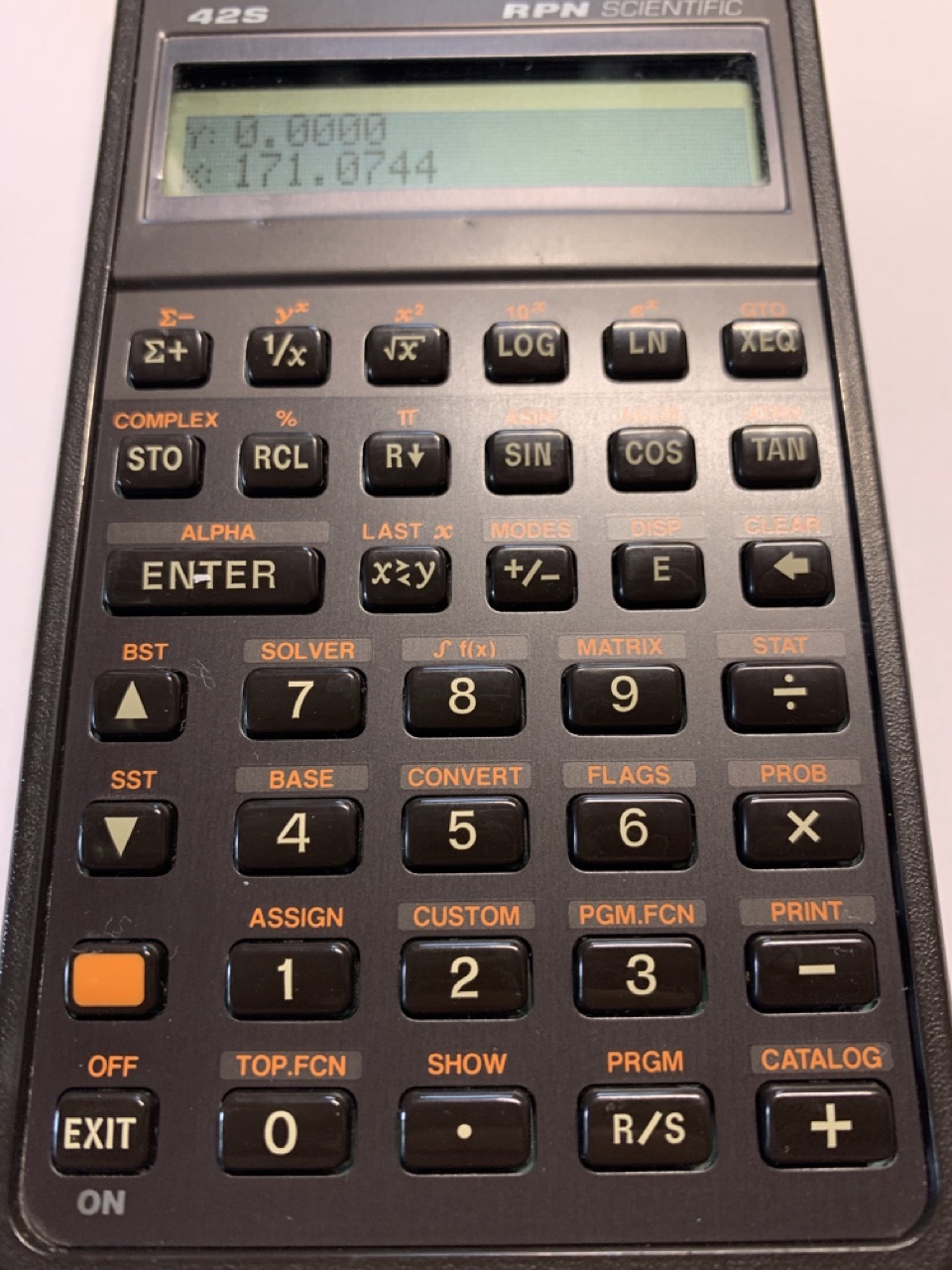Calculadoras Calculator blog Mensajes sobre el tema: HP42s
Calculator blog
Musings and comments about our common interest
HP42s
While the unit that I use every day is the HP15c (more now with more programs due to the extended memory we discussed in the previous blog), I realize that the best HP non-graphical calculator is the HP42s. (other competitors are the HP67 and the HP41c calculators). I have my own that I wll not part from. It joins the HP42 compatibility with much more memory, better speed and a very good extended set of functions covering matrix, complex and others. It only lacks the expandability of the HP41 - the rest is better in my opinion - even the keyboard feel is a the same level.
We have now one for sale, at 325€. It has very minor dents in the screen bezel, but it looks wonderful and it has excellent screen. Grab it while it lasts!!
Wsih list for Moravia-Royal
Now that the calculator business is in the hands of Royanl and Moravia, let's see what could be our wishist, now that the HP35s has been discontinued. A customer called me on Friday, and he told me "I want a RPN scientific calculator" - then I realized that there is no scientific RPN calculator anymore!!!
Rumours are that the HP12c will be put again in production (despite being in some dealers' inventories, it has been discontinued for at least 4-5 years). This would open the door for other Voyagers calculators - and I am thinking about my long time love - the HP15c - again.
Among the units in production we have the HP17bII+ - which is an excellent product and the most powerful current financial calculator. However, it has the same body and key disposition of the HP42s - so that is another possibility for a scientific calculator (the HP42s has not been bettered in my opinion) - with limited development time (both models could eventually be run on emulation layers with the original firmware)
However, the calculator market is based on school needs. These are best covered with the 300s+ and 10s+, and then with the Prime as graphical calculator (which runs circles around most of the competition).
I will try to send these thoughts to Moravia, who has been for some years my distributor.
New units coming in
Several news in our products:
-
There is a new boxed HP41CL in pristine state. The screen is not yellowish, the box comes with all manuals and even the stickers for your overlays are there! Pictures will follow.
-
We have also a very good, side-battery door HP19bII, with original manual in French.
-
And a new HP42S, just received. The bezel has some nicks, but barely appreciable. I have been playing with it, and it has warmed again my heart to it. RPN at its best, without its problems (try to use matrixes in any other RPN calculator, except the HP15c)
I will post all three in the website as soon as I can take the corresponding pictures.
On a different subject: we are quite sad to not being able to offer a good transport arrangement to our overseas customers. Even shipping outside the European Union is getting increasingly complicated for small shipments like ours. In the past, we were used to close to no paperwork. Now, with tax administrations trying to get resources from wherever they can, procedures are much stricter and therefore expensive. We will have to increase substantially shipment costs to the US
The mighty HP42s
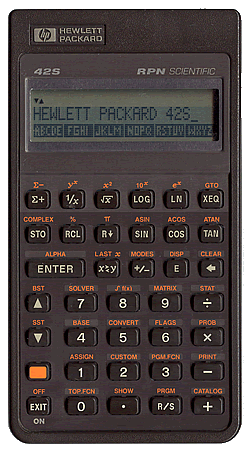
I think that very few people dispute that the HP42s is the top RPN calculator HP ever made. This definition discards all RPL calculators, that could be a worthy competitor for the title. However, except the Clamshell scientific-graphic calculators (the diverse HP28 variants), the RPL machines were big and difficult to be considered pocket calculators. The only other possible competitors were the HP15c (design factor) and HP41c (expandability). But on raw power, the HP42s handily beats both of them.
Once HP had moved to the Saturn architecture, and the HP41c started to show its age, HP decided to create a machine that was software-compatible with the HP41c - and much more. On the other hand, compatibility with all the moldings made for the Pioneer series forced the HP42s to be born without expansion ports - it only had a infrared port to communicate with the HP82240 printer.
To make it compatible with the HP41c, HP went back several notches in some of the attributes of the HP42s. One that drives me nuts is the solver. It still uses the RPN solver, equivalent to that of the advantage pack: you create a program and then you apply the solve routine. It had several advantages over the original: by defining the soft keys at the beginning of the program, they could be made to appear in the second line of the screen. But on the other hand, the solver that the HP17bii sibling already had was much more convenient - and I am still using it, 20 years later.
Other feature that keeps it midway modern and old design is that it has both registers (like the old HP41c) and variables (like the new RPL machines). It also has true matrixes and complex numbers built in - as it should be done. Complex numbers occupied only one stack level - like the HP15c but different from the HP41c additional modules. Complex numbers appeared naturally when the situation called for it (ex.: the radix of a negative number). Matrixes could be properly edited on the screen.
The machine had a menu system well organized, that let you arrive to your function in very few strokes. You could call it anyway with the XEQ button just like the HP41c.
I have one for sale. I have so much respect for it that I never use it to avoid damage, so what’s the point of keeping it? It has the particularity that its main memory has been increased to 32kb, instead of the original 8 kb. I have not performed the surgery, but you can read about the particulars here:
http://www.hpmuseum.org/cgi-sys/cgiwrap/hpmuseum/articles.cgi?read=199
Not that I have ever used the 8k original…but it always feels better to have a memory reserve!
Which calculator to take with you on a 2 weeks' holiday?
Leaving for holiday in a beach location. Still some work to do, but having been warned by “home management” that there are lots of things to pack from our children, and therefore I need to “travel light”.
Hearing “travel light” from my wife is at least surprising: she does not know what “travel light” means. My bags will will always be half of her’s - but let’s do the exercise anyway.
Which for the sake of this blog means which calculator(s) to carry with me. I have already decided not to take with me the HP41CL, although is the one I like best. It would be my solitary island choice - but not for a summer travel to a sun and beach destination. Too risky for its high value. So I have left it in Oslo.
I am taking with me the HP Prime. Now the question is whether I should take with me an HP15c - the HP42s suffers the same precautions as the HP41CL.
The main thing against the HP15c is that I will lose 1 hour with it at the beginning. Why? Because it lost all of the programs I wrote in it (235 steps of ugly code to fill in, with a lot of chances of getting some of it wrong). And I am used to my programs when working. I have it anyway on my Iphone.
And why the HP Prime and not the HP50g (with the promised comparison between both)? First, if we have to travel light, the Prime is thin and light. With its plastic cover, is probably the best protected calculator I ever had. What’s more, I can try to use it to get some of my children interested in maths (through calculators)
Then, why not both? That’s a question that I still need to answer to myself. After all, we’re only leaving next wednesday morning!
hp42s
For the next month, I have decided to use the HP 42s for my daily financial work. I find it better than the wp34s, due to its 2 line screen, and the fact that you can have the menu on screen much more easily than on the wp34s. Basically, it boils down to the same preference of the HP17bII over the faster and more function rich HP30b: user interface wins every time, and solver is key.
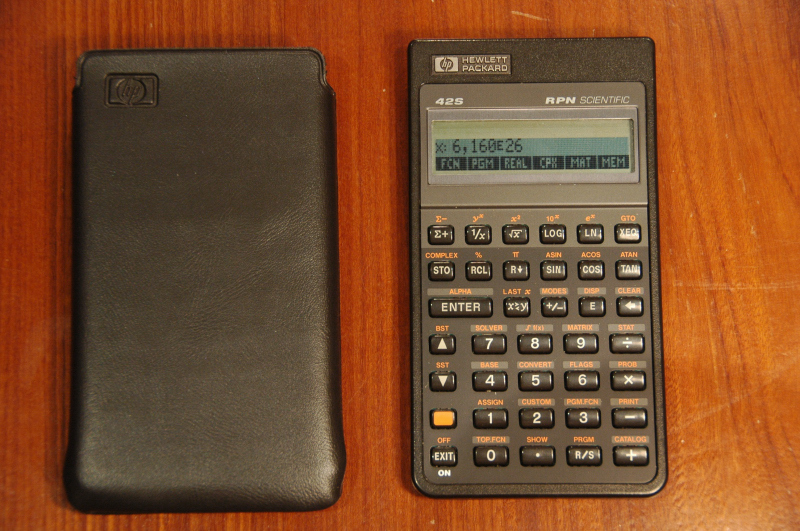
The solver in the HP42s is more cumbersome than on the HP17bII: you need to write a program, with a number of standard lines to define the variables being solved; this takes longer than just writing the algebraic expression, like on the HP17bII. The solver on the HP50g is prepared to take formulae from libraries (good for students), but you can define your own formulae and have them used in the solver.
On a more general level, it is a real pleasure to use a pristine example of a Pioneer series calculator. The keyboard is pure bliss to use - one would like to get the telephone book to add, such is the keying pleasure. Then, the fact of having two lines on the screen (sadly missed on most other Pioneer series calculators) helps a lot in knowing where you are (how many times did you key x><y because you did not know what you had in the y register?)
For the coming weeks, I will be carrying the trusty HP15c in my jacket pocket, and the 42s on the portfolio. Let's see which one wins in the long term.
No, it is not for sale.
wp34s - part 1
WP34s - a work in progress - Part I
The wp34s is a DIY attempt to replicate (and even improve upon) the HP42s, probably the best RPN calculator ever. Perhaps a little history is in order.
Hewlett-Packard created the programmable calculator market from scratch. The Hp65 first, and then the HP67, were the best calculators of their age, and they were the first to provide mass storage (if I remember correctly, "mass storage" means here a meagre 256 bytes. It is important to grasp the magnitude of this value: it is 1.000.000.000 times smaller than the hard disk of my Mac.
You really needed to be quite compact in your coding to be able to do something with that amount of memory. Well, in any case these were the best available handheld devices of their time and made their way to many spaceflights. There is even a website devoted to the HP calculator space history.
Then, the alphanumeric HP41c arrived.
It was purported as a handheld computer, and it was expandable - there was an enormous amount of peripherals and options, which made it able to do most handheld work of that time. Every one at that time wanted to have one - but not many could. On the other hand, the hp41c was barely pocketable; and the fact that many of its functions had to be addressed from the XEQ button made it less of a calculator. You really had to know the function catalog by heart to be able to take it to the maximum. Even though, and when you mastered, you had to type XEQ Alpha function keys Alpha - not very user-friendly.
In that respect, and in my humbler opinion, it was not as good as a pure calculator as its predecessors. As it was 100% customizable, you could reassign the hidden functions to the keys of your choice, and you even had removable keyboard overlays to show them - but it always left me with a feeling of DIY.
It also was limited in the number of functions and how they were implemented. Matrices and complex numbers come up to mind. Complex in particular were implemented in several HP and third party modules - but these were not compatible among themselves and in many cases led to just 2 stack levels available - not the right thing when you're calculating circuits!
Then the HP15c came. In many areas a step back from the HP41c (not expandable,not alphanumeric, programs stored as key codes, small memory area), it was a true handheld pure calculator. It had matrices and complex numbers done right, all functions were accessible from the front panel, and it could really fit in your shirt pocket.
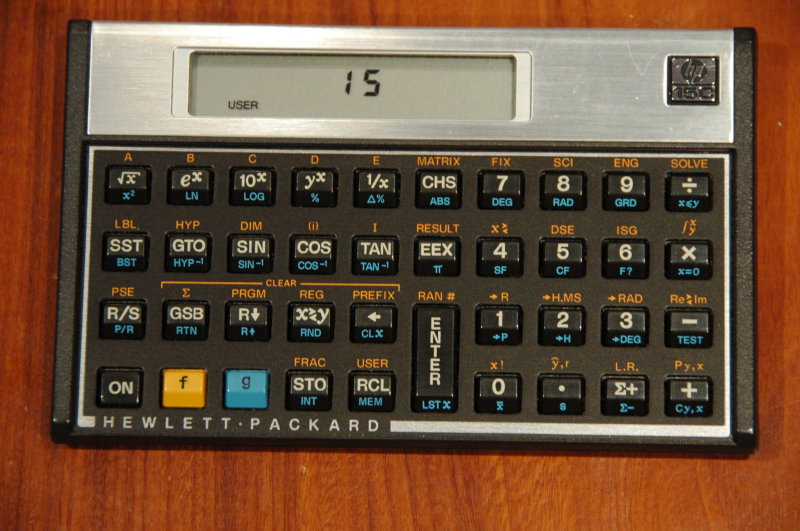
Still, many of us perceived it as second rate compared with the HP41c. We were comparing real world (hp15c) with potential capabilities when expanded (hp41c). Now, with perspective, I see that the 15c is the better calculator (not the better computer, not the better lab device, but the better calculator)
Then, HP released the HP71c - a true BASIC computer in calculator size, and later the HP28c, which was the first RPL device, and the distant root of both the Pioneer and HP48 families. Still, the HP41c remained the workhorse of the HP calculator family. Adding complexity to devices made them more suitable for class use - not necessarily for professional use.
When confronted with the aging but still bestseller HP41c, HP thought that there should be a software-compatible calculator, based in modern hardware, but still appealing to the HP41c calculator base. It should still be RPN, as opposed to the new series of calculators; and it should offer a better way of reaching the additional functions that the XEQ method.
The answer to that need was the HP42s. It had nearly total software compatibility with the HP41c, but it also had a menu-driven interface for the additional functions, and it integrated complex mathematics and matrices in a seamless way - much better even than with the hp15c; in fact, in my opinion, better than any other calculator, past or future. It had also a way of using the solver function and menus in normal programming. It also allowed techniques for keeping your stack safe when you were using programs.

(It was an irony, though, that the little machine, the zenith of RPN, was itself programmed in SysRPL)
Later, the HP48 family appeared, but it was already a different animal: unlimited stack, different object types, a more complex programming environment (elegant, but too different from the current programming mainstream to be able to grab attention). It was expandable, but not in the same way as the HP41c was. In fact, that kind of expandability has not been reached later. The fact that Agilent was spun off later made impossible to add instrument connectivity.
So that left us without continuation to the top RPN line. Later HP RPN calculators (like the HP32 in their various guises, the HP33s and the HP35s) do not hold a candle to the HP42s)
When HP issued the HP12c running as an emulation in an ARM processor, there was hope for us that HP could release a follow up of the HP42s. However, the kind of screens that could be driven from this processor were not as complex as the dot-matrix one used in the pioneer series like the HP42s. I questioned HP about their likelihood to produce an HP42s, since both the screen and the keyboard live on the HP17bII+. It seems that this is a closed avenue, since the processor used in that series could not seriously run the HP42s firmware; and the whole enterprise would be a significant R&D commitment, not worth in the current scheme of things.
Simultaneously, HP had issued a number of calculators using the SRM processor, and a way to modify it through a serial connector on the back: the HP20b and 30b. These were financial models, and quite powerful at that: as they are programmed in "native" code, and not running an emulator, they are the fastest HP calculators around, even faster than the HP50g in RPL.
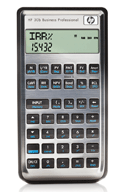
It was in this situation that Paul Dale and Walter Bonin set to produce a RPN calculator (to be continued in part II)
New Service - second hand equipment market
Here are the rules:
- This forum is devoted to the selling and buying of used equipment between registered users of the site.
- TheCalculatorStore bears no responsibility whatsoever regarding all businesses happening in the forum.
- TheCalculatorStore reserves itself the right to remove any add without giving reason.
- All operations are assumed to be customer-to-customer.
- TheCalculatorStore does not levy any fee whatsoever from either seller or buyer.
- Posts can be in any language the customer wants to use.
- Inclusion of pictures is recommended. In case of difficulties, please send pictures to jose@thecalculatorstore.com




